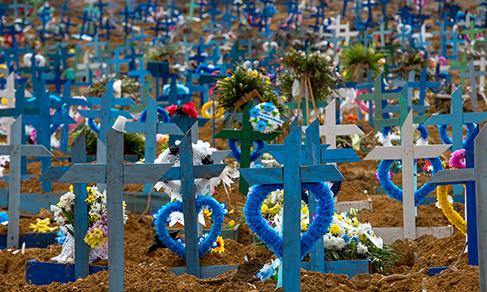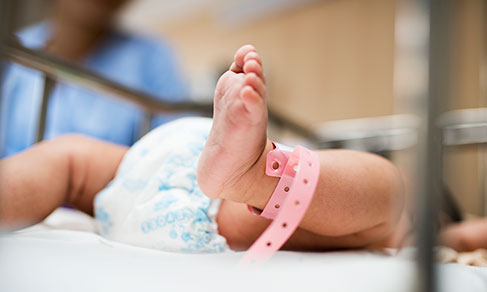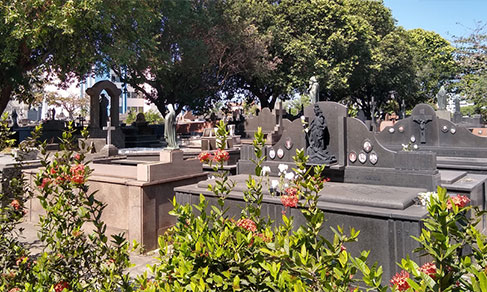Nossos serviços estão apresentando instabilidade no momento. Algumas informações podem não estar disponíveis.
System of Vital Statistics
 Experimental Statistics
Experimental Statistics
About - 2016-2019
The Capture-Recapture Technique has been applied by the IBGE to calculate the estimates of the total number of births and deaths and their underreportings, based on data of the Vital Statistics survey, carried out by the IBGE, and on administrative records of the Information System on Live Births (Sinasc) and of the Information System on Mortality (SIM) of the Ministry of Health. The first results spanned the period between 2015 and 2019, using the Generalized Linear Model (GLM), implemented after pairing those information sources, which allowed to assess the coverage of their records for the disaggregation levels of Brazil, Major Regions, Federation Units and Municipalities.
This study represents a methodological advance of that application, by introducing disaggregations for new variables in the 2016-2019 period. Thus, the following variables were selected in the case of births: Federation Unit and Municipality where the mother lives; age of the mother at childbirth time; place of birth; percentage of the municipal population of women aged between 25 and 39 years who completed secondary education; and population density of the Municipality based on the 2010 Population Census. The following were selected for deaths: Federation Unit and Municipality where the dead person lived; sex of the dead person; age group of the dead person; place of death; nature of death; percentage of the municipal population aged between 25 and 39 years who completed secondary education; and population density of the Municipality, both of them based on the surveying mentioned.
It is worth highlighting that these statistics are experimental, i.e., they are under assessment, since they still did not reach a complete degree of maturity in terms of harmonization, coverage or methodology.
The publication is also accessible on the IBGE portal, which makes available other information related to the System of Vital Statistics in Brazil.
 Experimental Statistics
Experimental Statistics
Tables - 2016-2019
Live Births (in xlsx and ods format) - updated on 10/11/2023 to include Table 1.5
Deaths (in xlsx and ods format) - updated on 7/10/2024 to include Tables 2.10 and 2.11
 Experimental Statistics
Experimental Statistics
Publications - 2016-2019
Description
It is a whole set of detailed information about vital statistics in Brazil, which includes the Vital Statistics survey, carried out by the IBGE, the data matching between this database and the databases of the Ministry of Health (Information System on Live Births - SINASC and Information System on Mortality - SIM) and the respective estimates of underreporting of births and deaths. In order to do this, a more robust methodology to calculate underreporting was developed, based on the application of data matching methods and of the Capture-Recapture technique to estimate the total number of live births and deaths - major purpose of the partnership between the IBGE and the Ministry, which includes the availability of the identified microdata of the sources previously mentioned.
The gathering of these microdata allowed to firstly carry out the data matching of live births and deaths in each of these databases. Besides being an intermediate step to estimate the respective underreporting, the data matching pinpoints the areas with shortage of coverage of events in each database, thus allowing the implementation of policies aimed at improving the enumeration of vital events, improvement of the information systems and eradication of underreporting.
Having completed the data matching, a second step consisted of applying the Capture-Recapture technique to estimate the total number of live births and deaths occurred in a given year. Once estimated these totals, their respective underreportings were calculated. It is important to highlight that the method applied allows the calculation of the coverage of records of births and deaths from each system (IBGE and Ministry of Health), according to groups or specific characteristics of the population, provided that these characteristics are represented by the variables used in the model.
It should also be highlighted that the System of Vital Statistics is updated on an annual basis, yet, due to unavailability of the information from the Ministry of Health, the estimates of underreporting of births and deaths and data matching show a one-year gap in relation to the reference year of the Vital Statistics survey.
Vital Statistics
The survey investigates live births, marriages, deaths and fetal deaths informed by the Offices of Civil Registry of Natural Persons, as well as divorces registered in Family Courts, Forums, Civil Courts and Notary Public Offices in Brazil, which, according to Law no. 11,441, of January 4, 2007, began to register out-of-court divorces not involving minors or incapacitated persons.
The current system of civil registry resulted from Decree no. 70,210, of February 28, 1972, which transfered to the IBGE the responsibility for collecting and calculating such information, then surveyed by the Service of Demographic, Moral and Political Statistics of the Ministry of Justice. The Vital Statistics are published by the IBGE since 1974, providing a comprehensive set of information on vital facts and marriages. The data on separations and divorces were incorporated into the survey from 1984 onwards. Resolution no. 175, of May 14, 2013, of the National Council of Justice (CNJ), prohibited competent authorities to refuse the qualification, celebration of civil marriages or conversion of stable unions into marriages between same-sex persons. This Resolution allowed the IBGE to survey such records from that date onwards. It should be highlighted that the data on live births, deaths, fetal deaths and marriages in the state of São Paulo result from the covenant signed with the State System for Data Analysis Foundation (Seade), which collects and calculates this information.
The survey provides information on live births by age of mother at childbirth time, places of registration and residence of mother, month of registration; on deaths by year of occurrence, age and civil state at death date, places of occurrence, registration and residence of dead person, month of occurrence, nature of death; on fetal deaths, by duration of pregnancy, age of mother at delivery time, places of birth, registration and residence of mother, month of registration, type of pregnancy; on marriages by month of occurrence and registration, age at registration date, place of registration, previous civil state; and on divorces by age of spouses at date of filing the divorce or date of deed, place where the divorce was filed or the deed was signed, nature of the divorce suit, matrimonial property scheme, responsible for the custody of children, decree delivered, time between marriage date and decree or notarial deed and type of family of the couple.
The periodicity of the survey is annual. The geographic coverage is national, with results released for Brazil, Major Regions, Federation Units, Metropolitan Areas and sub-divisions, Municipalities of Capitals and Integrated Development Regions (RIDEs).
Estimate of Birth Underreporting
Underreporting of births and deaths corresponds to the set of vital events not registered in the legal deadline. Although certificates are free of charge, social and economic vulnerabilities, expenditure with transportation, large distance between local communities and the Offices of Civil Registry of Natural Persons, usually present in areas with higher population density, manage to hinder the access of some population segments to such services.
As of 2015, the IBGE began to release every year, together with the release of the Vital Statistics survey, the estimates of the total number of vital events (births and deaths) ascertained by the survey and, consequently, their respective underreportings, as well as the underreporting of these events based on the Information System on Live Births (SINASC) and on the Information System on Mortality (SIM), of the Ministry of Health. The estimates of underreporting of births and deaths take into account the events occurred and not registered up to the first quarter of the year after the year of its occurrence, meeting the legal deadline to register it. In the case of underreporting of births, the indicator is associated with the coverage of the civil registry without the incorporation of late records, being particularly important to signal how far is Brazil from meeting the basic requirement of recognizing newborn children as citizens and, consequently, strengthening public policies towards the increase of such records.
Data Matching
Aiming at assessing the Systems of Vital Statistics (IBGE´s Vital Statistics and Ministry of Health´s SINASC and SIM), measuring how many vital events (births and deaths) were reached by the respective systems is required. In order to do this, the Vital Statistics, SINASC and SIM data suffered a matching procedure. Besides being an intermediate step for the estimates of underreporting of births and deaths, the data matching pinpoints the areas with shortage of coverage of these events in each one of the databases.
Time series
#seriehistorica2017102104514841
#seriehistorica2017102113327179
Downloads
Technical Information
Methodological considerations on Vital Statistics can be obtained in the Technical notes. Up to 2015, these notes were a chapter in the publication of the results and, from 2016 onward, they are released apart. You can check them on the following address: https://biblioteca.ibge.gov.br/index.php/biblioteca-catalogo?view=detalhes&id=7135.
News and Releases
Vital statisticsUnder-registration of Births and Deaths EstimatesData Matching
In 2023, deaths fall 7.9% among elderly persons aged 80 years and over
1.43 million deaths occurred in Brazil in 2023, registered up to the first quarter of 2024, a reduction...
16/05/2025
Vital statistics
IBGE publishes under-registration and underreporting of births and deaths in 2022
In addition to the totality of vital events (births and deaths) and under-registrations and underreporting,...
04/04/2024
Vital statistics
In 2022, the number of births falls for the fourth year and reaches the lowest level since 1977
Brazil registered 2.54 million births in 2022, a drop of 3.5% compared to 2021, when the number was 2.63...
27/03/2024
Vital statistics
In 2021, number of deaths exceeds that in 2020 and current series records lowest number of births
The number of deaths increased by 18.0% in 2021, about 273 thousand deaths more than in 2020, which amounts...
16/02/2023
Under-registration of Births and Deaths Estimates
Experimental study presents 2020 data on the underreporting of births and deaths
The IBGE releases today (14) the data of the Capture-Recapturevdata for 2020: Disaggregated estimates...
14/12/2022
Under-registration of Births and Deaths Estimates
Experimental study brings new disaggregation for data of births and deaths
The Capture-Recapture Study presents a more refined estimate of vital events: Disaggregate estimates...
06/04/2022
Vital statistics
In the middle of the pandemic, number of divorces drops 13,6% in 2020
Compared with the previous year, the number of divorces granted in Brazil fell 13.6% in 2020. In 2019,...
18/02/2022
Vital statistics
Death records increase by 14.9% in the first year of the pandemic and hit highest level in the series
The year 2020, which marks the start of the Covid-19 pandemic in Brazil, had a total 196 thousand more...
18/11/2021
Vital statistics
Vital Statistics 2020: number of death records increases by 14.9% and number of birth records decreases by 4.7%
The number of death records in Brazil in 2020 reached 1,513,575. Considering only deaths with known sex...
18/11/2021
Vital statistics
Vital Statistics 2019: number of marriage registers decreases 2.7% in relation to 2018
The number of marriage registers in Brazil reduced 2.7% between 2018 and 2019 (from 1,053,467 to 1,024,676)....
09/12/2020
Errata
Correction in the municipal tables of the 2020 Vital Statistics
Published date: 05/12/2022
Description:
An error was detected in the tables with municipal results of the 2020 Vital Statistics. Some municipal micro and mesoregions were without their quantitative records represented in the tables.
Actions: The file has been amended and replaced.Layout error and infographic resizing in the Survey of Vital Statistics 2017
Published date: 14/01/2019
Description:
In the process of creation of layout and resizing of the infographic "Proportion of divorces by person with custody of minor children, by Major Region (%)”, the horizontal lines were slightly misplaced, resulting in an incorrect location of scale markers.
Actions: The files were replaced.Replacement of the Publication Vital Statistics 2014
Published date: 30/11/2015
Description: Rectification of title, source and notes of Graph 5 and replacement of Table 9.
Actions: Errata included in printed publication. Publication replaced before being put out on the Internet.
City and country codes
Codes of Brazilian municipalities
Codes and acronyms of countries and territories
- Download the list of countries and territories in Portuguese (xls|ods)
- Access to the list in English on the United Nations website

Estas estatísticas são classificadas como experimentais e devem ser usadas com cautela, pois são estatísticas novas que ainda estão em fase de teste e sob avaliação. Elas são desenvolvidas e publicadas visando envolver os usuários e partes interessadas para avaliação de sua relevância e qualidade. Caso deseje deixar uma crítica ou sugestão, clique aqui para deixar sua opinião.













